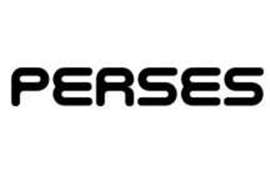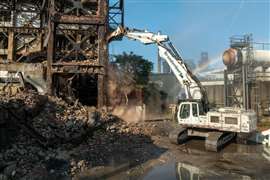Read this article in 中文 Français Deutsch Italiano Português Español
World Demolition Awards shortlist - Collaboration
28 August 2024
D&Ri is pleased to announce the Collaboration category shortlist for the 2024 World Demolition Awards, which will take place on 6 and 7 November October in Stockholm, Sweden, as part of the World Demolition Summit.
Congratulations to the following companies who made the Collaboration category shortlist.
World Demolition Awards 2024 - Collaboration shortlist
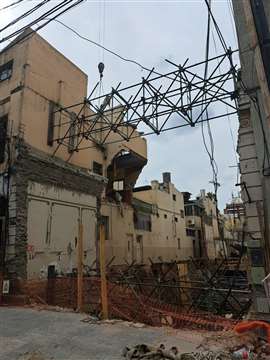 (PHOTO: Grupo Mitre)
(PHOTO: Grupo Mitre)
GRUPO MITRE
COUNTRY: Argentina
PROJECT: Derrumbe Caballito Collaboration in Demolition
CLIENT: Gobierno de la Ciudad de Buenos Aires
The demolition of a partially collapsed building on Pedro Goyena Street in Buenos Aires highlighted the critical role of collaboration in ensuring safety and efficiency.
This complex project involved coordinated efforts between Grupo Mitre, Civil Defense, Firefighters, Police, Forensic Teams, residents, and the City Government.
Key phases included the mobilization of equipment and materials, preventive shoring to stabilize adjacent structures, protective measures for neighboring properties, careful debris separation, and the use of a remote-controlled demolition robot Brokk 170 for precise and safe demolition.
After the demolition, a mini excavator was provided to assist the Buenos Aires Fire Department with forensic examinations, and a waterproof coating was applied to stabilize the exposed soil slope.
Additionally, an access walkway was constructed for residents whose homes had become inaccessible due to the collapse. This collaborative effort ensured that residents could safely return to their homes, highlighting our commitment to community welfare.
Psychological support was also provided to both the victims and the work team to cope with the stress and to assist neighbors who feared for their homes and families. Additionally, all materials generated by the demolition were reused as fill on-site to ensure structural containment.
The collaborative approach of the project resulted in efficient completion, enhanced safety with zero accidents, minimal community disruption, and reduced environmental impact through effective debris management.
The coordination among all parties involved was executed quickly and professionally due to the constant risk of further collapse. Grupo Mitre says this project exemplifies how collaboration can lead to successful outcomes in complex demolition scenarios. The contractor applied its emergency protocol to the project, allowing the work to be completed on time and without accidents.
“This project is a source of pride for us and a symbol of excellence and adaptability of our teams,” says Grupo Mitre.
KIEWIT
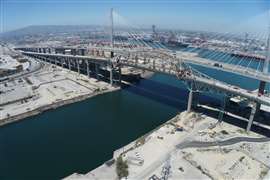 (PHOTO: Kiewit)
(PHOTO: Kiewit)
COUNTRY: United States
PROJECT: Gerald Desmond Bridge Demolition
CLIENT: Port of Long Beach
In July 2021, the Port of Long Beach (POLB) awarded the Gerald Desmond Bridge Demolition contract to Kiewit Infrastructure West Co. (Kiewit).
Demolition of the bridge spanning the Long Beach Inner Harbor Back Channel included removal of the main channel crossing and approach structures down to grade. The work was contracted for completion by January 2024.
All stages of the project required a high degree of collaboration between many stakeholders.
To reduce impact to Port operations and tenants, Kiewit opted to lower the bridge’s intact 410-ft suspended span to a barge during a 48-hour channel closure.
The project team worked together to develop a comprehensive plan that coordinated the timing of the 48-hour closure with POLB tenants and successfully completed the lowering operation and reopened the channel in only 18 hours.
Building off this early success the project team reached final completion in September 2023, four months early.
Despite the unique nature of the job and its many complexities, partnering and collaboration resulted in the following project successes:
•Kiewit and subcontractors worked the entire project recordable-injury free
•POLB saved over US$3 million
•Project completed four months early
•Zero environmental non-compliance notices
•Bridge lowering resulted in minimal impact on waterway traffic and completed 63% early
•Team was recognized with the coveted 2024 Associated General Contractors of America Marvin M Black Excellence in Partnering and Collaboration Award
Through hard work, dedication, and most importantly collaboration, the team worked as partners to develop and achieve common goals, leading to a highly successful project.
P. OLESEN
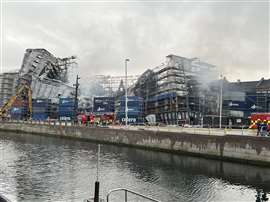 (PHOTO: P.Olesen & Sonner)
(PHOTO: P.Olesen & Sonner)
COUNTRY: Denmark
PROJECT: The Old Stock Exchange
CLIENT: Celero
On Tuesday, April 16th, a fire broke out the Old Stock Exchange building in Børsen in the center of Copenhagen.
The building was undergoing renovation works, for which a new copper roof was being installed. Scaffolding with plastic netting was set up around the entire building, both over the roof and on all four sides.
When the fire started, it quickly spread to the roof structure. Due to the scaffolding and plastic, it was very difficult for the emergency services to access the fire and extinguish it.
Several days were spent attempting to put out the fire, but it kept reigniting. The situation was uncontrollable, and the entire area in central Copenhagen was cordoned off by the police.
On Thursday, April 18th, the scaffolding collapsed. As the roof scaffolding was connected to the side scaffolding and a row of containers, the entire scaffolding structure twisted, putting great pressure on the old outer walls.
Celero Denmark A/S was called in to assist with this task. Celero is part of the Jensen Group and therefore requested J. Jensen Demolition to help with the task.
It quickly became apparent that this task required additional resources, and Celero also requested the assistance of Tscherning, P. Olesen, and Hockerup.
Together, we systematically dismantled the scaffolding and cleared the area around the building to preserve the remaining walls. During the cleanup, efforts were made to salvage as many fallen ornaments, statues, figures, etc., as possible among the burnt debris.
THOMPSONS OF PRUDHOE
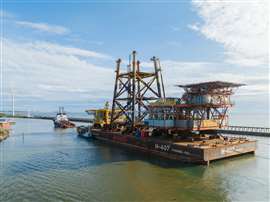 (PHOTO: Thompsons of Prudhoe)
(PHOTO: Thompsons of Prudhoe)
COUNTRY: United Kingdom
PROJECT: Audrey A and B & Ensign Topsides and Jackets
CLIENT: Spirit Energy Ltd.
Thompsons were appointed by Heerema Marine Contractors as their decommissioning subcontractor for the three redundant North Sea gas platforms Audrey A, Audrey B and Ensign (each comprising of one topside and one jacket). The structures combined weighed 5,490 tonnes.
Thompsons were responsible for the load-in, setting-down, dismantling, demolition and waste management of all six assets further to their arrival at Thompsons decommissioning facility at their Port of Blyth facility.
This was far from a ‘traditional’ demolition project, in fact it was the first of it’s kind for Thompsons. It was therefore even more important to develop positive collaborative relationships with other key stakeholders in order to achieve a common goal of completing the work to specification, on time, on budget and with no accidents or incidents.
The key stakeholders included Spirit Energy, Heerema Marine Contractors, Port of Blyth, Mammoet and Thompsons.
Collaboration between the key stakeholders was so important because each party was the project expert within their own sector.
The interface between each stage of project required multiple stakeholders to have an input. The high hazard nature of the work at each interface simply did not allow for failure, meaning that it was essential that all people on the project worked as one team irrespective of their employer.
The successful completion of the project was testament to all parties involved and most importantly the way in which they worked together, with a drive to achieve a common goal.
WARD DEMOLITION
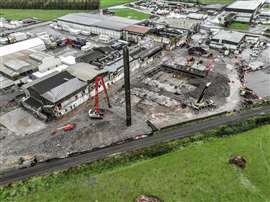 (PHOTO: Ward Demolition)
(PHOTO: Ward Demolition)
COUNTRY: New Zealand
PROJECT: Longburn Freezing Works
CLIENT: Talleys Group
Longburn Freezing Works was constructed in 1890 with additions added up until it’s closure in 1987.
The 20,000 square-metre-site suffered serious decay, partial demolition and salvage theft, over its 30 years of abandonment before Ward Demolition was engaged for the clearing of the site.
Constructed during the thick of the Asbestos Era the structures were severely contaminated, with over 800 tonnes of friable and non-friable materials present throughout.
Another key challenge was the 44-metre-high concrete tower that required demolishing within 5 metres of a live KiwiRail train track.
Due to the size and complexity of the job, it required a collaborative approach between our Auckland based team and our Wellington division to get the job completed safely.
35,910 hours of labour went into the two-year-long project. One of the key challenges of collaborating between two separate regional branches of Ward Demolition is ensuring effective communication and coordination between teams that are physically distant from one another.
This task could easily lead to delays, misunderstandings, and inefficiencies in project management. It was important for both branches to establish clear lines of communication through regular meetings, shared project management tools, and documentation processes. Standardization of procedures and protocols across both branches helped streamline operations and ensure consistency.
Ultimately, successful collaboration between regional branches requires strong leadership, effective communication strategies, and a commitment to overcoming logistical barriers for the benefit of the overall success of the project.
CONNECT WITH THE TEAM





